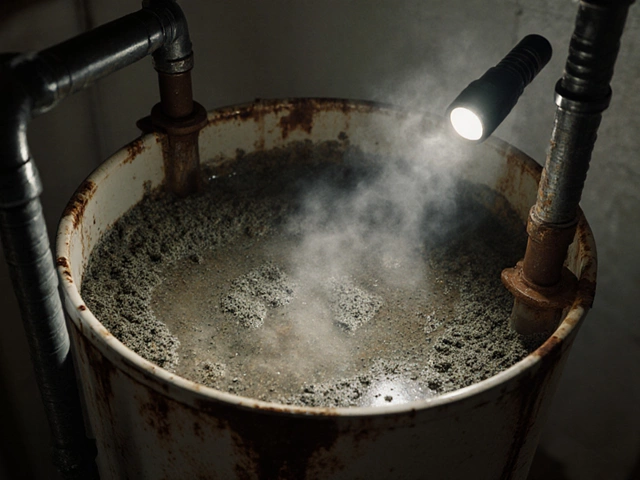Understanding how to describe an appliance goes beyond just stating the brand and size. Imagine you're on the phone with a technician, and they're asking for details you might not even think about. Knowing what to say can save time and ease frustrations. So, what's the first step in cracking this code?
Start with the basics. Every appliance has a model and serial number. These little clusters of characters are often the golden ticket to identifying exact features. They're usually lurking on the inside of a door or back panel—take a peek. Trust me, these numbers are your best friend when explaining your appliance to a service pro.
The devil is in the details, they say. While model numbers are crucial, don't forget to mention if your appliance has special features or quirks. Is your washing machine high-efficiency? Does your fridge have a water filter? The more you share, the better the service provider can assist you.
- Getting to Know Your Appliance
- Identifying Key Features and Components
- Common Issues and How to Describe Them
- Practical Tips for Effective Communication
Getting to Know Your Appliance
First things first, let's talk about where to find the details you need to know about your appliance. Every appliance is like a puzzle piece in your household puzzle, and each has its own unique identifiers. Knowing where these identifiers are hidden can make life a whole lot easier.
Locate the Model and Serial Numbers
These numbers are like your appliance's ID card. Look inside doors or behind panels for these crucial bits of information. They usually consist of a string of letters and numbers. Not only do they help in appliance description, but they’re also super handy when you're seeking appliance service.
Understand Basic Functions and Settings
Get familiar with the basic functions your appliance offers. Take your washing machine, for example; knowing whether it includes a delicate cycle or a high-spin option can make a big difference in how you describe its functionality. The same goes for a fridge with adjustable temperature settings or a dishwasher with eco-friendly modes.
Recognize Special Features and Technology
Brands love to market their latest tech advances. Whether it's a fridge that you can control with your phone or an oven with a smart sensor, these factors are important. It’s these little details that help service professionals understand what they're working with.
Check the Appliance Manual
Don't underestimate the power of the user manual. While many people choose to ignore these booklets, they contain a wealth of info—everything from troubleshooting tips to maintenance advice can be found here.
| Feature | Importance |
|---|---|
| Model Number | Identifies exact specification for parts |
| Serial Number | Determines age and warranty status |
| Manual | Source of solutions and maintenance tips |
Once you have all this knowledge at your fingertips, you'll find that describing your home appliances becomes a breeze. You'll talk like a pro, whether you're explaining an issue or simply chatting with friends about your latest tech additions.
Identifying Key Features and Components
Alright, let's get into the nitty-gritty of what makes your appliance tick. Understanding its key features and components can seriously up your troubleshooting game and make you a champ at describing what's going on if things go south.
First off, let's talk about the standard components. Most appliances, like washing machines and fridges, have some universal bits—think motors, filters, and seals. Knowing these parts and how they work is like having a cheat sheet for quick fixes and better descriptions. It'll also help you pinpoint where things might be going wrong.
Spotting Special Features
These days, appliances are loaded with special features. High-efficiency modes, smart controls that connect to your phone, or even fancy settings like steam refresh in dryers. Spotting these can be as easy as checking the control panel or seeing what kind of cycles are listed. Take note of anything that stands out because it's all super useful info when trying to explain your appliance to a pro.
Understanding Labels and Buttons
A label decoder is what you need here. Yeah, the buttons and labels might seem boring, but they actually tell you a lot. You see a button with a snowflake icon on your fridge? That's for controlling the freezer temp, likely. And those symbols on your dishwasher? They tell you which cycle's currently running. Don't skip these details—they're your secret weapon for giving an accurate description.
The Power of Knowing Specific Parts
You don't need to be a tech whiz, but knowing specific appliance parts can give you an edge. Is your oven acting up? Knowing whether it's the heating element or the thermostat might be causing trouble can save both your time and the technician’s. Having some parts knowledge can especially speed up service repairs.
So, next time you're peering into that appliance manual or pressing the buttons, think about what you're seeing. Not only will it help you describe issues accurately, but it'll also empower you to use those appliance features to their full potential.

Common Issues and How to Describe Them
When your appliance starts acting up, describing what's wrong is crucial for getting it fixed quickly. Here are some typical problems and tips on how to explain them to a repair service.
Unusual Noises
Is your appliance making a racket? Whether it's a washing machine thumping or a fridge humming, distinct sounds can point to different issues. Note the noise type—is it a rattle, click, or hum? Mention when it happens, like only during a spin cycle or when the fridge kicks on.
Leaking
Leaking is another common headache. First, pinpoint the leak's location. Is it coming from the front, back, or underneath? Also, note if the leak happens only when your appliance is in use. This info can help zero in on whether it's a hose issue or something more internal.
Not Turning On
When your appliance just won't turn on, check the basics first—plugged in and switched on? If everything looks good but still no power, try explaining the last time it worked. Did it suddenly stop or slowly deteriorate over time?
Performance Issues
If your appliance is on but not performing well, details matter. Does your dryer take forever to dry clothes? Or maybe your dishwasher doesn't clean as it should. Share specific symptoms like longer cycle times or remaining residues after washing.
| Issue | Potential Cause | Additional Details to Provide |
|---|---|---|
| Unusual Noises | Loose parts, motor problems | Type and timing of noise |
| Leaking | Hose issues, seals | Location and occurrence of leak |
| Not Turning On | Power issues, internal failure | Last known good operation |
| Performance Issues | Blocked filters, worn components | Symptoms and frequency |
Being specific when communicating these common problems with your service provider can make a world of difference in getting your home appliances back in shape quickly and effectively.
Practical Tips for Effective Communication
When you're dealing with appliances, sometimes it feels like speaking another language. Effective communication, especially about appliances, means being clear and precise. It's not just what you say, but how you say it. Let's break it down with some tips.
Gather All the Essential Details
Before you pick up the phone, have all the relevant information at hand. You want to start by noting down the model number, serial number, brand name, and any features you think might be unique or relevant. These details make it easier for a technician to know exactly what they're dealing with.
Describe the Problem Clearly
Sounds simple, right? But often, we leave out crucial points. Instead of saying "my dishwasher isn't working," try to specify what's wrong. Is it not cleaning dishes well, or is it not draining? Specifics help the technician diagnose the problem faster.
Use Common Language
While industry terms might sound impressive, they can sometimes lead to confusion. Stick to simple descriptions. For instance, instead of saying "thermostat seems faulty," say "the heater isn't heating properly." Straightforward language is more understandable.
Provide Context
When did the issue start? Has it been intermittent or constant? Providing history helps in diagnosing ongoing issues. Note changes in your home appliances function after certain events, like power outages or moving houses.
Be Ready for Follow-up Questions
Sometimes, service providers will need more details, especially for tricky problems. Be ready to answer questions about noises, smells, or odd behavior of your appliances.
Stay Calm and Patient
It’s easy to get frustrated when discussing problems with appliance service technicians. Staying calm ensures you communicate concerns accurately and keep the conversation productive.
These communication strategies save time and help fix issues efficiently. Remember, being prepared and articulate in your descriptions can significantly enhance the troubleshooting process for any appliance service.




